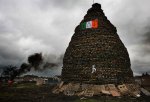
Martin McAleese
Working quietly away from the media spotlight, Martin McAleese has been persuading Ulster Loyalists to engage more fully in the peace process
Another step in the peace process in Northern Ireland seems to have taken place. Unconfirmed reports gave the first indications that the Ulster Volunteer Force (UVF) has destroyed its arsenal of weapons in the presence of the disarmament leader Gen. John de Chastelain and other independent observers, and the Ulster Defense Association has initiated a similar process.
The news overshadowed another report that the process has been assisted by other workers for peace. According to the BBC [Saturday June 27th 2009]:
Martin McAleese, the husband of the Irish president Mary McAleese, was working behind the scenes as the largest loyalist group, the UDA, [Ulster Defense Force] dealt with the weapons issue. He helped persuade hard line Belfast loyalists like Jackie McDonald that they had nothing to fear from the peace process in general, and the Dublin establishment in particular.
The two men not only talked at great length, they reportedly played golf together. It was an unlikely combination – an Irishman and an Ulsterman, a Catholic and a Protestant – swinging golf clubs rather than punches. In recent years, Mr McAleese has worked quietly in the background, seeking progress rather than publicity.
The Belfast-born dentist is more used to negotiating pain-barriers than political barriers, but he displayed sensitivity and a steady hand in the murky world of loyalism.
Martin McAleese appears to have all the hallmarks of a fifth-level leader whose own ego does not intrude into his actions and their impact on others. I suppose I was particularly intrigued about the role-reversal here. The high-profile President of Ireland, and the behind-the-scenes influence of her husband. [Just to avoid confusion: I’m not suggest that Mary McAleese is particularly ego-driven, and I’d like to get something in Leaders we deserve on that remarkable leader as well].
The BBC article suggests that there are varied motivations behind the activities of the various groups still committed to violence. Most commentators have considered that there was far more than undiluted sectarian zeal behind the operations on both sides of the sectarian divide as turf battles extended into protection rackets, drug scams and assorted abuses of power.
What’s Interesting
What’s interesting from a leadership perspective is further evidence of the benefits of non-charismatic modes of leadership in tough conflict-resolution processes. I’ve picked up the story of Martin McAleese, but the wider story includes other leaders, some charismatic some not so.
The Northern Irish Peace Process over a period of decades has been marked by the multiple influences of people some more obviously charismatic, others of a more self-effacing kind.
The roll of honour includes the long-suffering John Major who as British Prime Minister constantly struggled to emerge from the mighty shadow cast by his predecessor Margaret Thatcher. Major was stereotyped as the ultimate grey man, and anti-leadership leader.
It also included the anxiety-ridden David Trimble, whose every move towards peace weakened his own power base, contributing to the political rise of the Reverend Ian Paisley, feared by the catholic minority for his fiery renditions of the Protestant no-surrender message were seen as a major block to the peace process.
Later, there was widespread approval for the fact that Ian Paisley as leader of the Democratic Unionist Party had consented to sit in the same room with Sinn Fein leader Gerry Adams.
Paisley was subsequently to form a warm working relationship with Martin M, another former Sinn Fein leader . This was the same man whom Dr Pasiley used to describe as a Sinn Fein IRA terrorist,
Tony Blair, the charismatic leader, and Bertie Ahearn, whose lower key style was more akin to that of John Major, had also played important roles in the eventual signing of the Good Friday agreement.
Clearly, the process is not a simple linear advance inspired by one leader’s vision. Few would expect it to be so.
Lewin’s magnificent contribution
Over have a century ago, the great social scientist Kurt Lewin made one of the most important contributions to our thinking of how major changes takes place. His idea was that social systems, like scientific systems, have inherent stability. There are a set of forces which hold the system in stable equilibrium. An action which might change the system has the effect of activating what amounts to ‘an equal and opposite reaction’ (Newton’s terminology). The result is a perturbation after which the system eventually returns to its stable position. Lewin’s Force Field theory is stronger on stability than on change. (Although on management courses it is presented as suggesting the merits of addressing those reactionary forces opposing change. The theory helps us understand why attempts to achieve political goals will not be simple cause-effect chains.
More recent attempts to understand social and organisational change change have focused on tipping points and chaos theory .



 Posted by Tudor Rickards
Posted by Tudor Rickards 





 Click for regular updates
Click for regular updates